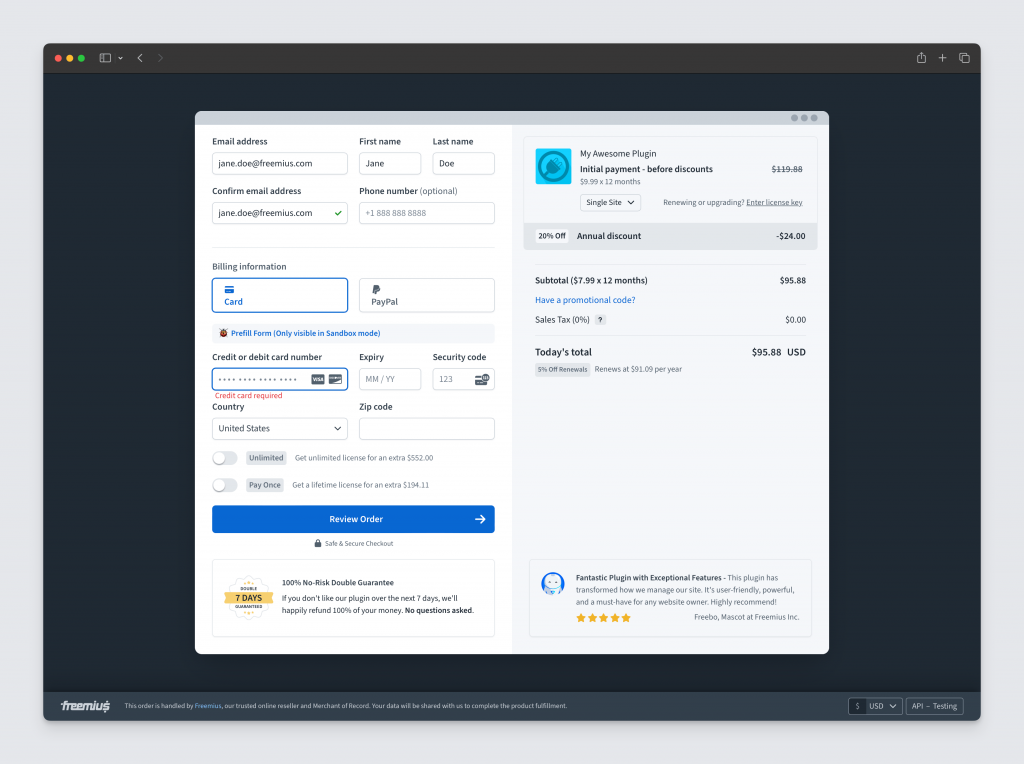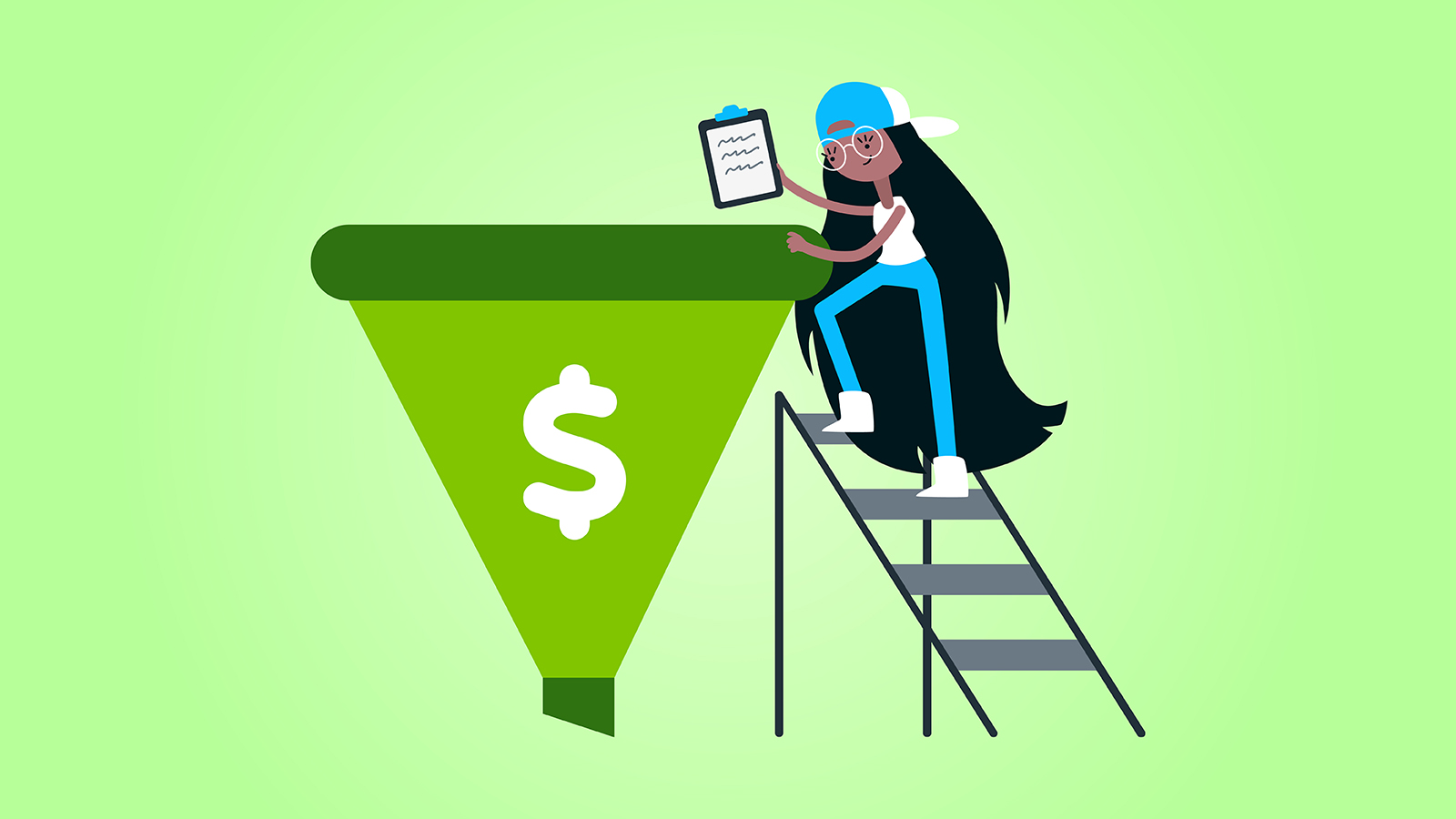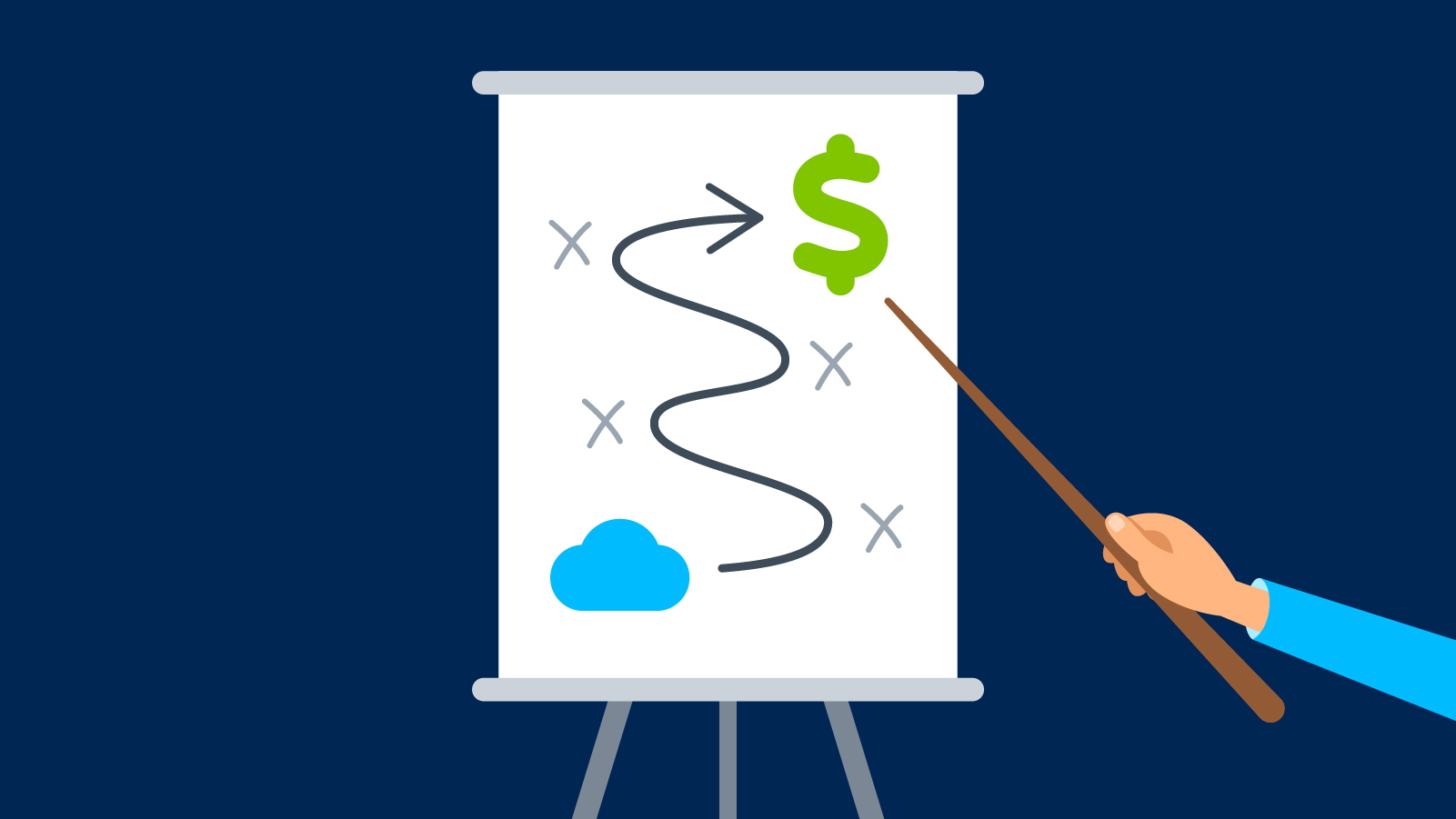|
|
Let’s cut to the chase: Selling WordPress plugins ain’t easy. Solo plugin makers and SMBs in the space need to use all means available to convert customers and drive revenue.
Implementing effective sales funnels can address challenges like low visibility, high competition, and inconsistent revenue streams. Speaking of revenue: If you’re using the freemium business model, a solid sales funnel can greatly aid in converting more free users to paying subscribers 💰
By investing time to optimize each stage of the sales funnel, plugin businesses can differentiate themselves, better understand their customers, and ultimately boost their bottom line.

Sounds good, right? 😉 Before we lay out the blueprint, let’s first discuss…
What Is a Sales Funnel for a WordPress Plugin?
A sales funnel for a WordPress plugin takes potential customers through a series of steps. These steps lead them from first learning about the plugin to finally buying it (and more).
While the number of steps in a sales funnel may vary based on your business and sales model, the main goal is to create a seamless journey that engages potential customers and motivates them to buy.
The practice of offering a free version of your plugin to capture leads, followed by targeted marketing efforts to upsell to a paid version, can be far more effective when implementing a well-designed and robust sales funnel.
It’s also important to note that a sales funnel differs from a marketing funnel.
A marketing funnel covers the entire customer journey and focuses on the “bigger picture”: building a brand, establishing expertise in your niche, etc.
A sales funnel specifically addresses the steps leading to conversion and may be considered a process within the overall marketing funnel itself.
Why Is a Sales Funnel Important for WordPress Plugin Businesses?
Better Understanding of Customers
Monitoring customers’ behavior at each stage of the sales funnel provides insights into preferences and pain points. This info helps you tailor marketing materials and personalize promotions to hit the mark with your audience.
Efficient Use of Resources
A sales funnel helps you maximize your resources. Digging into funnel analytics can reveal the channels that bring in the most cash.
For example, you may be putting a lot of effort into marketing but notice that your competitors are winning more customers than you. After some analysis, you notice that they offer more educational content about their plugins, giving potential customers the necessary knowledge to confidently make a purchase.
Armed with this data, you can allocate your resources efficiently by focusing more on educational content creation than marketing, which could lead to a better return on investment.
Improved Customer Retention
The sales funnel extends beyond the purchase. By following up with emails, personalized communication, and excellent customer support, you can enhance loyalty and drive repeat purchases. You can go even further with these four strategies that help retain customers by reducing churn and increasing subscription renewal rates for your plugin.
Maximized Revenue Potential
A well-optimized sales funnel ensures more prospects are converted into paying customers.
Each stage of the funnel must be designed to move customers closer to a purchase decision by capitalizing on every interaction.
Better User Experience
Streamlined processes and personalized interactions make it easier for customers to purchase by minimizing friction and frustration. These positive experiences can also encourage future purchases and brand loyalty.
Effective Marketing Spend
Plugin makers can make the most of their marketing budgets by focusing on the most productive channels and tactics. Funnel optimization helps identify which strategies yield the best results, allowing for smarter resource allocation. This ensures marketing efforts are cost-effective and yield optimum ROI.
Increased Conversion Rates
Fine-tuning your sales funnel can work magic on conversion rates for your WordPress plugins. By identifying and fixing bottlenecks in the funnel, you can guide customers toward making a purchase.
The bottom line: a sales funnel can be a game-changer for plugin businesses. It provides a roadmap for understanding the customer journey and nudges prospects to convert.
So, what does an effective sales funnel for WordPress plugins look like? To answer this question, we need to break down the basics first.
Grab a free copy of our Cheat Sheet for
Selling Plugins and Themes
A growth roadmap with concise, actionable tips for every milestone of WordPress product development.

Sales Funnel Steps
Typically, a traditional sales funnel consists of four steps: Awareness, Interest, Desire, and Action. They outline the conversion progression of a customer, starting from when they first become aware of a product or service to taking action and making a purchase.
- Awareness: The customer learns about the plugin through marketing efforts like blog posts, social media, or ads.
- Interest: The customer shows interest by exploring the plugin’s features and benefits, often by visiting the website or reading reviews.
- Desire: The customer realizes the plugin’s potential to solve their problems or improve their website.
- Action: The customer takes the final step by buying and installing the plugin.
Ultimately, a sales funnel helps you make it as logical and easy as possible for customers to move from one step to the next and purchase your plugin.
However, while the traditional sales funnel provides a clear and logical blueprint of the typical customer journey, it fails to account for the complexities of modern-day online businesses and their products and services + how this impacts relationships with potential and existing customers.
To address these shortcomings, we made a video explaining the more evolved funnel that’s used by companies like Github and Ahrefs.
Let’s take a look at how you can apply the modern-day marketing funnel to your plugin business.
Using the Modern-Day Marketing Funnel for Selling WordPress Plugins
The traditional (some would say obsolete) sales funnel is a straightforward process where the relationship with the customer typically ends after the purchase.
However, in the modern-day funnel, the journey continues well after making a sale and shifts to building long-term loyalty and advocacy.
These are the different stages:
- Raise awareness: Creating content that addresses the problem your plugin solves + establishing your brand as an authority without directly selling.
- Nurture interest: Becoming the audience’s “go-to” source by consistently producing unique, useful content related to the issues your plugin addresses.
- Spark desire: The first two stages are largely about building brand awareness. From here, the focus shifts to educating prospective customers on how your plugin addresses their specific needs, emphasizing customer success.
- Facilitate purchase: Highlighting the impact of your plugin through landing pages, product videos, demos, and pricing pages, and focusing on existing customers’ achievements.
- Encourage adoption: Providing onboarding support and using feedback forms to address issues and ensure customers use your plugin optimally.
- Cultivate loyalty: Ensuring customers enjoy using your plugin by offering excellent support and collecting feedback to minimize churn and encourage repeat purchases.
- Motivating expansion: Upsell to satisfied customers with bundles, add-ons, or plan upgrades with more features, premium support, etc. Remember that existing customers are more likely to buy from you again.
- Advocacy and affiliation: Promoting referral programs and affiliate opportunities to turn loyal customers into advocates, which helps to spread the word and complete the marketing cycle.
By focusing on these stages, you attract and convert new customers and also retain and expand your relationship with existing ones. Ultimately, this sales funnel creates a sustainable growth cycle for your WordPress plugin.
By implementing and tracking a few basic metrics, you’ll be on your way to crafting a killer sales funnel for your plugin.
Metrics to Optimize Your Sales Funnel and Maximize Sales Potential
Conversion rate measures the percentage of site visitors who complete a desired action, such as making a purchase.
A high conversion rate of 2-5% means your funnel persuades visitors to take action, suggesting that your messaging, USP (unique selling proposition), and funnel design resonate with them.
Bounce rate tracks the percentage of visitors who leave your site after viewing only one page. A high bounce rate of 55% or higher might indicate that your nav needs improvement. Visitors may not be finding what they’re after or some pages may not be engaging enough to encourage further exploration. You can fix this by improving landing page content, design, and relevance to the sales funnel’s stage.
Average order value (AOV) calculates the average amount spent each time a customer completes a purchase. This metric provides insights into the effectiveness of upselling and cross-selling strategies within the funnel. AOV can be optimized with things like plugin bundles, promotions, and personalized recommendations.
Customer lifetime value (CLV) estimates the total revenue your WordPress plugin business can expect from a single customer throughout the relationship. Optimize the sales funnel for customer retention through personalized follow-ups, exceptional customer service, and loyalty programs.
Freemius is a helpful tool for tracking sales funnel metrics. Our Sales and Analytics Dashboard can help you analyze performance indicators like sales, refunds, and chargebacks.
A big part of sales funnels is about figuring out where you’re losing leads:
- Freemius’s automated cart abandonment recovery helps you engage with customers who abandon their carts by giving them a friendly nudge, which enhances engagement, improves loyalty with exclusive offers, and increases revenue by as much as 7.5%.
- Remember when we said the sales funnel continues long after the purchase? Whenever a customer abandons your plugin, we send them a deactivation feedback form to gather data that helps you understand why they uninstalled your product (and hopefully helps you win them back too). This information can aid in improving your offering to avoid losing other customers for the same reasons.
But how do you put a sales funnel together — specifically for selling WordPress plugins?
Essential Building Blocks for a Stellar WordPress Plugin Sales Funnel
These are the core elements of a winning sales funnel for WordPress plugins. Successfully incorporating them will help you streamline the optimization process.
Email marketing is essential for nurturing leads and driving conversions. It allows you to send personalized and automated email campaigns that engage potential customers at different stages of the sales funnel. By delivering relevant content, special offers, and reminders directly to your leads’ inboxes, you can maintain continuous engagement and guide them towards making a purchase.
Landing pages are crucial for capturing leads and driving conversions. They simplify the customer journey by providing a focused and relevant entry point tailored to specific sales campaigns (like BFCM) or special offers. Well-designed landing pages with clear call-to-actions (CTAs) remove distractions, guide visitors toward desired actions, and can also boost conversion rates.
Lead generation forms collect information from potential customers, allowing you to nurture leads through targeted marketing campaigns. These forms simplify the customer journey by making it easy for visitors to express interest and provide their contact details. By placing these forms strategically on landing pages or within content, you can remove obstacles to lead capture. Collecting this data enables personalized follow-ups, ensuring your leads receive relevant information and offers.
An optimized checkout will also reduce friction during the purchase process, leading to higher conversion rates and fewer abandoned carts. A great checkout streamlines the customer journey by minimizing steps and simplifying the payment process with clear instructions, multi-currency support, etc.
Once you’ve assembled the tools, how do you put the sales funnel together?
How to Create a Winning Sales Funnel for WordPress Plugins
Creating an effective sales funnel for WordPress plugins involves several approaches, each tailored to different business needs and technical expertise. You can use dedicated plugins that simplify the process with pre-built templates and automation features or build custom funnel pages for more control and customization. Both methods have their advantages, and the choice depends on your specific requirements (read: how stubborn you are 😅).
Using SaaSes and plugins to create sales funnels is often the quickest and easiest method. ConvertKit, Elementor, Gravity Forms, Popup Maker, and Freemius offer robust features that streamline the creation and management of your sales funnel. These tools integrate seamlessly with WordPress, making it simple to design and optimize each stage of the funnel.
ConvertKit is an excellent tool for email marketing, allowing you to automate and personalize your email campaigns. It helps you nurture leads by sending targeted emails based on user behavior, ensuring that your prospects receive the right messages at the right time. ConvertKit’s intuitive interface and powerful automation features make it easy to segment your audience and deliver highly relevant content, driving engagement and conversions.
Elementor is a powerful page builder that enables you to design custom funnel pages without any coding knowledge. With its drag-and-drop interface, you can easily create visually appealing landing pages, product pages, and checkout pages that guide users through your sales funnel smoothly.
For lead generation, Gravity Forms combined with Gravity Flow is a highly effective solution. Gravity Forms allows you to create advanced forms to capture lead information, while Gravity Flow automates the follow-up process, sending a series of emails and directing users to the next step in the funnel. Popup Maker can help you grow your email list with conversion-focused campaigns using popups, slide-ins, banners, and more.
Freemius’s dual-column checkout can be particularly helpful for creating an effective sales funnel for WordPress products.

The innovative checkout design maximizes the use of desktop display real estate, reducing the need for users to scroll and making the purchase process more intuitive and user-friendly.
The modernized UI and UX minimize distractions and guide buyers through the process effortlessly. Additionally, the checkout incorporates upsells for annual, lifetime, and unlimited licenses strategically placed to increase conversion rates and average purchase amounts.
Features like a money-back guarantee and showcased reviews add social proof, boosting buyer confidence. By optimizing the checkout for conversion rate optimization (CRO), the checkout ensures a smoother, more effective purchasing experience that drives higher revenue.
The plugins and tools we’ve listed can help you create a winning sales funnel that simplifies the customer journey, removes obstacles, and enhances the overall user experience. If done correctly, it could play a significant role in driving more conversions and increasing your revenue.
Why You Need Sales Funnel Vision
Sales funnels help drive revenue and growth because they compel you to systematically consider every aspect of a potential customer’s journey to purchasing your plugin.
A well-designed sales funnel provides insights into customer behavior, enabling data-driven decisions and efficient resource allocation. By focusing on each stage, you can boost conversion rates, increase average order values, and improve customer retention. Investing the time to assemble the correct tools + building blocks and the metrics to track them can have a significant impact on your plugin’s success.
If you have any questions about setting up a sales funnel for your plugin or would like us to give you a few pointers, feel free to drop us a DM on X.








